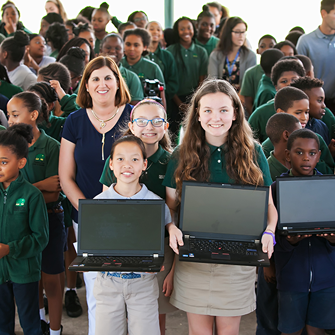
Sustainable development is a widely-discussed topic that holds great significance in our modern world. With increasing concerns about the environment, depletion of natural resources, and the need for long-term solutions, understanding sustainable development is crucial.
In this article, we will explore the concept of sustainable development, its fundamental principles, and the key components that make up this vital approach to our future.
Sustainable development can be defined as the practice of meeting present needs without compromising the ability of future generations to meet their own needs. It aims to strike a balance between economic growth, social progress, and environmental protection. It prioritizes responsible resource management and seeks to minimize the negative impact of human activities on the planet.
Sustainable development rests on four essential pillars:
Environmental sustainability focuses on preserving and restoring the natural environment. It emphasizes actions that reduce pollution, protect biodiversity, and conserve natural resources. This pillar encourages sustainable practices such as recycling, using renewable energy sources, and promoting ecosystem preservation.
Economic sustainability looks at the long-term viability of economic activities. It promotes the idea of a robust and inclusive economy that generates sustainable jobs, ensures fair distribution of wealth, and fosters innovation. Economic sustainability encourages investments in renewable energy, efficient technologies, and responsible business practices.
Social sustainability puts people at the forefront. It focuses on ensuring that all individuals have access to basic needs like food, water, healthcare, education, and equal opportunities. It promotes social justice, human rights, gender equality, and inclusive communities. Social sustainability aims to create a harmonious society that cares for its members and future generations.
Cultural sustainability recognizes the importance of preserving diverse cultural traditions, heritage, and identities. It values the interconnectedness of cultures and encourages respect and understanding among different communities. Cultural sustainability acknowledges that vibrant cultures are essential for fostering collective identity, creativity, and social cohesion.
Several key principles guide sustainable development:
Sustainable development promotes fairness between current and future generations. It recognizes that resources should be used responsibly to ensure that future generations can also meet their needs. It encourages sustainable practices that safeguard the planet for the long term.
The precautionary approach requires decision-makers to take preventive measures when facing uncertain risks. It encourages the avoidance of actions that could harm the environment or public health, even in the absence of conclusive scientific evidence. It prioritizes minimizing potential negative impacts.
Sustainable development relies on cooperation between governments, businesses, organizations, and communities. It emphasizes the importance of integrated decision-making processes that consider social, economic, and environmental aspects. Collaboration is crucial to achieving a holistic and balanced approach to development.
Sustainable development recognizes the importance of involving all stakeholders in decision-making processes. It values the voices of individuals, communities, and organizations affected by development efforts. Collaboration and engagement ensure that diverse perspectives are considered, fostering inclusivity and empowering marginalized groups.
Understanding sustainable development is essential in order to address the pressing challenges of our time. It requires a comprehensive approach that balances economic progress, social well-being, and environmental preservation. By prioritizing the four pillars of environmental, economic, social, and cultural sustainability, we can work towards a future that is equitable, resilient, and thriving for both current and future generations.
Fill out the form below to request your electronics recycling pickup.
We’ll coordinate the schedule logistics and follow up with next steps.
From day one, showing how we handle old electronics isn’t just a nice gesture—it sends a clear message about what the company cares about. If recycling is built into the onboarding process, new hires immediately see that this is a place where actions match words.
When someone joins a company, they’re looking for signs of how things are really done. If they see from the start that devices are collected, reused, or donated responsibly, they feel part of something consistent.
The numbers back this up. According to TechClass, nearly three out of four millennials would accept a lower salary to work for a company with strong sustainability practices. More than half say they’d stay longer if those practices are real and visible.
Beyond sending a message, e-waste recycling has practical benefits: lower disposal costs, recovery of valuable materials, better data security, regulatory compliance, and a stronger public image.
Alongside safety rules and benefits, explain the recycling program. For example: “When you receive a new laptop, you return the old one so it can be wiped, checked, and reused. That way it doesn’t end up in the trash.”
Numbers are important, but stories stick. Some U.S. retailers have kept hundreds of tons of e-waste out of landfills every year through internal programs. A few universities have gone further, sending outdated computers to local schools instead of discarding them.
At eSmart Recycling, we’ve seen old equipment repaired and delivered to children and families who wouldn’t otherwise have access to technology. That link between what one company no longer needs and what another person desperately does is powerful.
Is this just symbolic? No. It saves money, secures sensitive data, helps avoid fines, and reduces storage needs.
How do we measure it? With clear metrics: number of devices collected, percentage reused, data destruction reports, and devices donated.
Isn’t it extra work? Not if it’s explained from the start as part of everyday practice. When included in onboarding, it feels natural.
Adding e-waste recycling to onboarding is more than organizing a process—it’s showing what matters from the very first contact with the company. At eSmart Recycling, we’ve learned that every laptop collected makes a difference in an office and also in someone’s life.
Can a company spark real change by going full “Marie Kondo”? Absolutely. At eSmart Recycling, we believe that organizing, decluttering, and letting go of what no longer serves you doesn’t just “spark joy”—it creates tangible impact for the planet and the community.
At its core, Marie Kondo’s method is about keeping only what sparks joy, encouraging more conscious and sustainable choices. For a U.S. company aiming to lead in sustainability, this means reviewing aging tech assets and deciding—what should we keep, refurbish, or recycle? The difference is doing it with purpose, not just obligation.
The e-waste tsunami is real: in 2022, the world generated about 62 million tons of it, yet only 22% was properly recycled. That’s a mountain of valuable resources wasted, plus serious environmental risks. The time to act is now.
And the market reflects it: the e-waste management industry is projected to grow from $70 billion in 2024 to $81.27 billion in 2025. For your company, this isn’t just duty—it’s an opportunity to lead.
Based in Tampa, we’re committed to double impact—environmental and social. We collect, audit, and securely destroy data under HIPAA standards. We revalue equipment, allocate about 30% of revenues to repairs and donations, and deliver reports, certificates, and measurable impact for our partners.
Every device that no longer sparks joy in your IT room can be transformed into an opportunity for someone else.
Salesforce automated the retirement of 40,000 servers: cutting manual effort by 80%, saving 10,475 MWh (enough energy for 83 households per year), and avoiding 3,506 metric tons of CO₂—equal to the annual carbon sequestration of 15,336 acres of U.S. forest.
In 2024, Dell used more than 95 million pounds of recycled or renewable materials in its products. Over 96% of its packaging was reused or renewable. They’ve even designed laptops with modular USB-C ports and accessible batteries, aiming to recycle or reuse as much as they sell by 2030.
Decluttering your tech isn’t just about space or compliance—it’s a statement of values. Choosing responsible recycling says the future matters, your people and communities matter, and the planet is non-negotiable.
At eSmart Recycling, we see it daily: we turn storage rooms full of forgotten gear into equipped classrooms, more efficient offices, and solid ESG reports for our partners. That’s how Marie Kondo mode becomes a corporate strategy that truly sparks joy—joy in a cleaner planet, children with access to opportunities, and businesses with purpose.
The next step is yours: will you let obsolete tech gather dust, or will you turn it into real impact with us?
When we collect old equipment from companies, we know that what appears to be a dusty storage closet can become something far greater: a fully equipped classroom, a connected community center, or a gateway to new opportunities. At eSmart Recycling, this is the mission we carry forward every single day.
From Tampa, we’ve been transforming tons of outdated technology into tools for learning and inclusion. This year alone, we’re processing about half a million pounds of electronics, keeping them out of landfills and extending their useful life.
We’ve donated more than 3,000 computers and devices to underserved communities, working alongside over 50 nonprofit organizations across five countries.
In Tampa Bay, we set up a full digital lab at the Salesian Boys and Girls Club (West Tampa), in partnership with BayFirst Bank. We’ve also collaborated with the Hillsborough Education Foundation, AMRoC FabLab, Pace Center for Girls, Hope For Her, and many other local nonprofits.
During a community laptop drive for the Boys & Girls Clubs, we collected 131 devices, at least 25 of which were reusable—each one a Windows 10 Pro machine ready for remote learning.
Through a partnership with the University of South Florida in St. Petersburg, we received 500 used computers to refurbish and distribute to community organizations, students, and adults in Pinellas County.
Our work doesn’t stop in the U.S. Through our alliance with the Nuestra America Foundation, we’ve delivered recycled devices to rural schools, community centers, and youth programs across Latin America. In one rural center, students who previously had no access to computers can now research online and connect with the wider world.
Recently, in Peru, we donated 30 refurbished computers to the Ronald McDonald House and Corazones Felices. As a result, a brand-new computer lab now serves around 70 children and teenagers, helping them develop their digital skills.
We’re driven by the belief that electronic recycling can truly close digital divides. In Tampa, we saw companies discarding thousands of perfectly functional computers at the same time nonprofits were struggling to provide technology to families in need. That disconnect inspired us to act.
Since 2016, we’ve created a model where every piece of equipment gets a second—and often better—life: as an educational tool in the hands of kids, families, and communities with limited access to technology.
Every time we pick up a device, we know we’re preventing e-waste while opening doors for students. What once sat forgotten in a closet now powers education, creativity, and connection. And when those screens light up, it’s not just the computers that come alive—it’s the future of the communities we serve.
Let’s be honest: recycling laptops, servers, or cellphones isn’t always top of mind for companies. And not because it’s unimportant, but because excuses always pop up. The truth? Most of them are easy to dismantle. Here are three of the most common ones—and how you can move past them without overcomplicating things.
The first reaction is usually: “This is going to cost a fortune and take weeks.” And yes, e-waste recycling does involve separating materials, handling toxic metals, and meeting regulations. It’s not something just any IT team can improvise.
The good news: some take-back programs and partnerships make it simple. At eSmart Recycling, we handle everything—pickup, logistics, compliance. You just choose when and where.
Another classic excuse: “Why spend money on this if it doesn’t generate revenue?” The reality is that the value isn’t always immediate. It’s in hitting ESG goals, strengthening brand reputation, and reducing carbon emissions.
For context: recycling metals like gold or copper consumes far less energy than mining them from scratch. Still, only 10–15% of the gold inside e-waste is actually recovered. That’s an enormous amount of wasted resources. With us, you can reuse devices internally, resell them, and unlock real value from what’s sitting in storage.
The fear of an old hard drive ending up in the wrong hands is a valid concern. Nobody wants a data breach. But this shouldn’t stop you—today, there are certified processes for data erasure, degaussing, and shredding that eliminate sensitive information for good.
The EPA highlights that devices, if properly treated, are a valuable resource. At eSmart Recycling, we follow strict security protocols and provide certificates of data destruction so you can meet regulations and rest easy.
In 2025, postponing tech recycling isn’t an option anymore. The world produces over 60 million tons of e-waste every year, and only a fraction is managed properly.
The difference between your company staying stuck in excuses or moving into action is choosing the right partner. At eSmart Recycling, we turn barriers into opportunities: real sustainability, full compliance, and a stronger reputation.
You may not notice it, but your company could be hoarding electronic waste (e-waste). Old computers in storage, routers nobody uses anymore, hard drives forgotten in a drawer. All those things you keep around “just in case” rarely come back to life. In the meantime, they take up space, create risks, and slow down your sustainability goals.
Holding on to outdated technology might seem harmless, but it isn’t. Obsolete devices with sensitive information can become an open door to cyberattacks or fines for failing to comply with regulations like HIPAA or GDPR.
And it’s not just about physical space. Digital hoarding is just as costly: duplicated files, disorganized emails, and unused data stored forever. All of this costs money in infrastructure and energy, while also putting your company’s data security at risk.
A clear plan to identify, de-inventory, and properly dispose of outdated assets prevents buildup and helps you stay in control.
There are no shortcuts here — if you want to handle e-waste responsibly, you need a trusted partner. At eSmart Recycling, we are certified, we securely destroy data following the highest standards, and we operate under a triple-impact model: environmental, social, and economic.
What does this mean in practice? While we help you comply with regulations like HIPAA and GDPR, we also give a second life to part of your equipment by donating it to kids and families in need. You solve a problem and, at the same time, create a real positive impact.
Don’t let e-waste pile up. Set quarterly or semi-annual collection days to keep your space organized and minimize risks.
Before recycling, make sure all data is wiped or destroyed under accredited standards. That way, you protect sensitive information and avoid compliance issues.
Processes only work if people understand them. Educate employees on how to recycle and manage digital clutter. Building a culture of sharing — not hoarding — information makes a big difference.
By adopting these practices, you:
At eSmart Recycling, this is our everyday work: we collect outdated devices, securely destroy the data, refurbish what we can, and donate technology to communities that need it most. Your company can join this model and turn a liability into an opportunity for real impact.
At eSmart Recycling, we always say that giving out computers is only part of what we do. What really drives us is the way people connect through technology.
Tony Selvaggio, our founder, expressed it in a way that inspires us every day: it’s not enough to provide access — what matters is how the community uses that technology to grow together and stay connected. That phrase is the compass guiding every project.
The digital divide is not a thing of the past.
These numbers make something very clear: donating equipment helps, but it doesn’t solve everything. The real challenge is to provide guidance, teaching, and spaces where technology can truly be used.
From our experience, several elements change the game:
On September 12, we were in St. Petersburg at the PSTA eRevolution Drive. It was a day that said it all.
People showed up with laptops, phones, and even game consoles. But the most valuable part wasn’t the devices — it was the energy of the gathering. Every conversation, every smile when handing over a device, showed that this is about much more than recycling: it’s about sharing a common purpose.
That day made it clear that the digital divide doesn’t close with wires and screens alone, but with the strength of a community moving together.
What we do has several layers:
It’s more than just access to technology, is bringing the community together to maximize the power of technology and become a digitally connected and empowered community” – Tony Selvaggio
What inspires us is simple: when technology comes together with community, the possibilities multiply. A refurbished device can be the key to an online class, a new job, or a family connection.
That’s what we strive for: every delivery to be paired with relationships, learning, and shared experiences. Every event has a chance to bring people together around something bigger.







If you want to know more about the different programs, partners, and overall cool things happening in the eSmart world, share your email with us, and Join the E-Revolution.
